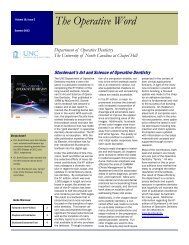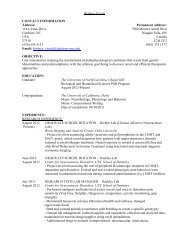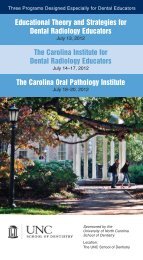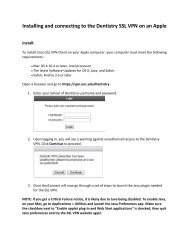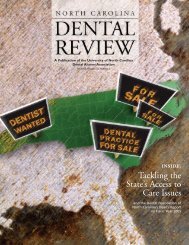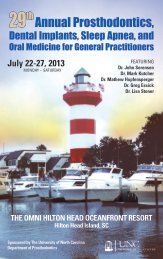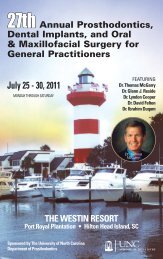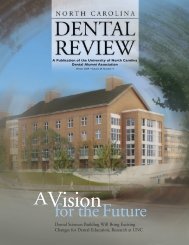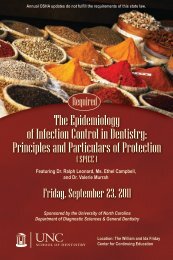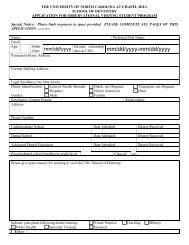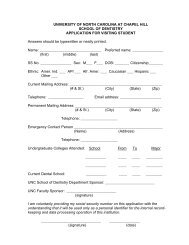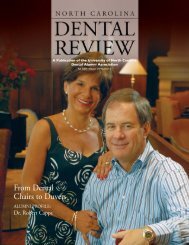UNC School of Dentistry - The University of North Carolina at ...
UNC School of Dentistry - The University of North Carolina at ...
UNC School of Dentistry - The University of North Carolina at ...
Create successful ePaper yourself
Turn your PDF publications into a flip-book with our unique Google optimized e-Paper software.
#45 Usage P<strong>at</strong>terns <strong>of</strong> Web-Based Teaching Modules by Dental StudentsA. CAVENAUGH and L. KOROLUKDepartments <strong>of</strong> Pedi<strong>at</strong>ric <strong>Dentistry</strong> and OrthodonticsObjective: Web-based teaching modules have been used as adjuncts to traditional textbooks for self-directedlearning. However, there is a lack <strong>of</strong> evidence concerning the utiliz<strong>at</strong>ion p<strong>at</strong>terns <strong>of</strong> online resources in thesesettings. This study investig<strong>at</strong>ed the time and frequency <strong>of</strong> module utiliz<strong>at</strong>ion by dental students and therel<strong>at</strong>ionship between module utiliz<strong>at</strong>ion and examin<strong>at</strong>ion performance in a growth and development course.Methods: <strong>The</strong> course is divided into 4 units (A, B, C, D) with unit examin<strong>at</strong>ions and a final examin<strong>at</strong>ion. Studentsaccessed the orthodontic online teaching modules with a user name and password. This log-in protocol was used torecord the d<strong>at</strong>e and time when a student accessed the modules. <strong>The</strong> d<strong>at</strong>e <strong>of</strong> each log-in was c<strong>at</strong>egorized as: 1-3days, 4-6 days and >6 days before each examin<strong>at</strong>ion. Each student could access the modules multiple times. <strong>The</strong>final examin<strong>at</strong>ion was comprehensive covering all course m<strong>at</strong>erial from all four units. <strong>The</strong> rel<strong>at</strong>ionship <strong>of</strong> finalexamin<strong>at</strong>ion scores and module usage was analyzed. Results: <strong>The</strong> total number <strong>of</strong> times logged in for each studentduring the entire course was significantly correl<strong>at</strong>ed with their final examin<strong>at</strong>ion grade (Spearman correl<strong>at</strong>ionr=0.26, p=0.02). <strong>The</strong> percentage <strong>of</strong> students who logged in <strong>at</strong> least once for each unit was for Units A, B, C, D,and the Final Exam: 1-3 days: 85.0, 96.3, 97.5, 71.3, 93.8; 4-6 days: 95.0, 55.0, 45.0, 50.0, 0.0; >6 days: 46.2,0.0, 17.5, 32.5, 0.0. Fewer students accessed the modules early as the course progressed, the majority waiting until1-3 days before the examin<strong>at</strong>ions. Conclusions: <strong>The</strong> use <strong>of</strong> online teaching modules can positively affectperformance in dental school courses. <strong>The</strong> majority <strong>of</strong> students waited to access the teaching modules a few daysbefore the examin<strong>at</strong>ions.#46 Do <strong>The</strong>y Really Differ from Us? -- P<strong>at</strong>tern <strong>of</strong> Tooth loss in Older Adult with DementiaX. CHEN 1 , S. K. SHUMAN 2 , J. S. HODGES 2 , and L. C. GATEWOOD 21 Department <strong>of</strong> Dental Ecology, <strong>UNC</strong> and 2 <strong>University</strong> <strong>of</strong> MinnesotaObjective: Older Adults with Dementia (OAD) experience more oral disease compared to non-demented elders.OAD are also considered having higher risk <strong>of</strong> tooth and oral functional loss. However, detailed p<strong>at</strong>tern <strong>of</strong> toothloss among OAD remains unknown. Due to lack <strong>of</strong> inform<strong>at</strong>ion, dental pr<strong>of</strong>essionals face gre<strong>at</strong> challenges incaring for OAD. <strong>The</strong> objectives <strong>of</strong> this study were to study the impact <strong>of</strong> dementia on tooth survival and detailp<strong>at</strong>tern <strong>of</strong> tooth loss in OAD when tre<strong>at</strong>ment is available. Methods: 491 dent<strong>at</strong>e older adults, including 119 OAD,were retrospectively recruited. Subjects were tre<strong>at</strong>ed and brought to a st<strong>at</strong>e <strong>of</strong> health, and then assigned into twogroups based on the diagnosis <strong>of</strong> dementia. Medical and dental assessments were abstracted from dental records.Tooth loss events were recorded for subjects during follow-up (mean=39 months). Propensity score m<strong>at</strong>ching wasused to elimin<strong>at</strong>e impact <strong>of</strong> differences in characteristics associ<strong>at</strong>ed with tooth loss from comparison <strong>of</strong> dementedand not-demented subjects. Cox, Poisson and Neg<strong>at</strong>ive Binomial regressions were used to study p<strong>at</strong>terns <strong>of</strong> toothloss. Results: <strong>The</strong> mean number <strong>of</strong> remaining teeth <strong>at</strong> arrival among demented subjects was 18, 2 teeth less thanth<strong>at</strong> <strong>of</strong> non-demented subjects. 27% <strong>of</strong> the remaining teeth in demented group were roots or had caries <strong>at</strong> arrival,compared to 19% in non-demented subjects (P=0.0006). P<strong>at</strong>tern <strong>of</strong> tooth loss did not differ between demented andnon-demented subjects when tre<strong>at</strong>ment was available. On average, subjects started to lose teeth about 20 monthsafter enrollment. By 48 months, 31% <strong>of</strong> non-demented subjects and 37% <strong>of</strong> demented subjects lost <strong>at</strong> least onetooth (P=0.5). Incidence r<strong>at</strong>e <strong>of</strong> tooth loss was 15% in both groups. Mean numbers <strong>of</strong> teeth lost in 5 years were1.21 for demented subjects and 1.01 for non-demented subjects (P=0.89). Conclusion: Oral health was poor inOAD. However, when intervention was given, the impact <strong>of</strong> dementia on tooth survival was not st<strong>at</strong>isticallysignificant. Demented subjects did not lose more teeth than those without dementia. R<strong>at</strong>e <strong>of</strong> tooth loss in dementedsubjects also did not differ from th<strong>at</strong> in non-demented subjects. Supported by <strong>University</strong> <strong>of</strong> Minnesota DoctoralDissert<strong>at</strong>ion Fellowship31



